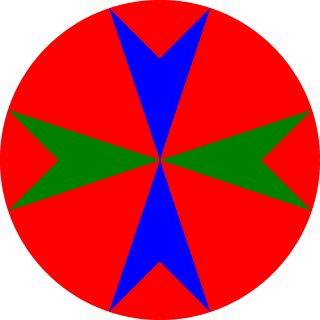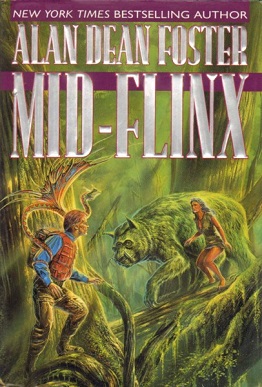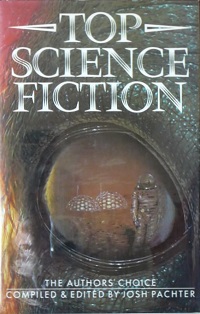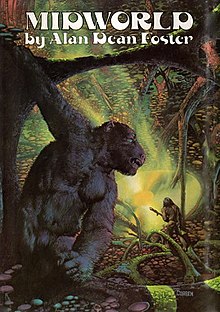
Paul Myron Anthony Linebarger, better known by his pen-name Cordwainer Smith, was an American author known for his science fiction works. Linebarger was a US Army officer, a noted East Asia scholar, and an expert in psychological warfare. Although his career as a writer was shortened by his death at the age of 53, he is considered one of science fiction's more influential and talented authors.

A Dyson sphere is a hypothetical megastructure that encompasses a star and captures a large percentage of its solar power output. The concept is a thought experiment that attempts to imagine how a spacefaring civilization would meet its energy requirements once those requirements exceed what can be generated from the home planet's resources alone. Because only a tiny fraction of a star's energy emissions reaches the surface of any orbiting planet, building structures encircling a star would enable a civilization to harvest far more energy.

Mars, the fourth planet from the Sun, has appeared as a setting in works of fiction since at least the mid-1600s. Trends in the planet's portrayal have largely been influenced by advances in planetary science. It became the most popular celestial object in fiction in the late 1800s when it became clear that there was no life on the Moon. The predominant genre depicting Mars at the time was utopian fiction. Around the same time, the mistaken belief that there are canals on Mars emerged and made its way into fiction, popularized by Percival Lowell's speculations of an ancient civilization having constructed them. The War of the Worlds, H. G. Wells's novel about an alien invasion of Earth by sinister Martians, was published in 1897 and went on to have a major influence on the science fiction genre.

Citizen of the Galaxy is a science fiction novel by American writer Robert A. Heinlein, originally serialized in Astounding Science Fiction and published in hardcover in 1957 as one of the Heinlein juveniles by Scribner's. The story is heavily influenced by Rudyard Kipling's Kim.

An overwhelming majority of fiction is set on or features the Earth, as the only planet home to humans. This also holds true of science fiction, despite perceptions to the contrary. Works that focus specifically on Earth may do so holistically, treating the planet as one semi-biological entity. Counterfactual depictions of the shape of the Earth, be it flat or hollow, are occasionally featured. A personified, living Earth appears in a handful of works. In works set in the far future, Earth can be a center of space-faring human civilization, or just one of many inhabited planets of a galactic empire, and sometimes destroyed by ecological disaster or nuclear war or otherwise forgotten or lost.

The Humanx Commonwealth is a fictional interstellar ethical/political entity featured in the science fiction novels of Alan Dean Foster. The Commonwealth takes its name from its two major sapient species, who jointly inhabit Commonwealth planets and administer both the political and religious/ethical aspects. They are the mammalian Humans of the planet Earth and the insectoid Thranx which dwell upon Hivehom. The Commonwealth is described as a progressive, well-intentioned liberal democracy spanning many star systems, and is somewhat similar to the United Federation of Planets from Star Trek. The Humanx Commonwealth is notable for its portrayal of a human–alien relationship that is not just mutually beneficial but symbiotic, allowing an amalgamation of the two species.

Planetary romance is a subgenre of science fiction in which the bulk of the action consists of adventures on one or more exotic alien planets, characterized by distinctive physical and cultural backgrounds. Some planetary romances take place against the background of a future culture where travel between worlds by spaceship is commonplace; others, particularly the earliest examples of the genre, do not, and invoke flying carpets, astral projection, or other methods of getting between planets. In either case, it is the planetside adventures which are the focus of the story, not the mode of travel.

Man of Two Worlds (1986) is a science fiction novel by American writers Brian and Frank Herbert.

The planet Venus has been used as a setting in fiction since before the 19th century. Its impenetrable cloud cover gave science fiction writers free rein to speculate on conditions at its surface—a "cosmic Rorschach test", in the words of science fiction author Stephen L. Gillett. The planet was often depicted as warmer than Earth but still habitable by humans. Depictions of Venus as a lush, verdant paradise, an oceanic planet, or fetid swampland, often inhabited by dinosaur-like beasts or other monsters, became common in early pulp science fiction, particularly between the 1930s and 1950s. Some other stories portrayed it as a desert, or invented more exotic settings. The absence of a common vision resulted in Venus not developing a coherent fictional mythology, in contrast to the image of Mars in fiction.

Lords of the Starship is a 1967 science fiction novel by American author Mark S. Geston. His debut work, it was written while he was a sophomore at Kenyon College. It was originally published in paperback by Ace Books, then reprinted for the British market in hardcover by Michael Joseph in 1971 and in paperback by Sphere Books a year later. Gregg Press published an archival edition in 1978 ; and Baen Books included it in its 2009 omnibus of Geston's early novels, The Books of the Wars.

Non-Stop is a 1958 science fiction novel by British writer Brian Aldiss. It is about problems that the inhabitants of a huge generation space ship face after an alien amino acid that they picked up on another planet triggers a pandemic. Law and order began to collapse, and knowledge of the ship and of its purpose was eventually almost entirely lost throughout the vessel.

Saturn has made appearances in fiction since the 1752 novel Micromégas by Voltaire. In the earliest depictions, it was portrayed as having a solid surface rather than its actual gaseous composition. In many of these works, the planet is inhabited by aliens that are usually portrayed as being more advanced than humans. In modern science fiction, the Saturnian atmosphere sometimes hosts floating settlements. The planet is occasionally visited by humans and its rings are sometimes mined for resources.

Pluto has appeared in fiction as a setting since shortly after its 1930 discovery, albeit infrequently. It was initially comparatively popular as it was newly discovered and thought to be the outermost object of the Solar System and made more fictional appearances than either Uranus or Neptune, though still far fewer than other planets. Alien life, sometimes intelligent life and occasionally an entire ecosphere, is a common motif in fictional depictions of Pluto. Human settlement appears only sporadically, but it is often either the starting or finishing point for a tour of the Solar System. It has variously been depicted as an originally extrasolar planet, the remnants of a destroyed planet, or entirely artificial. Its moon Charon has also appeared in a handful of works.

Mid-Flinx (1995) is a science fiction novel by American writer Alan Dean Foster. The book is the sixth chronologically in the Pip and Flinx series.

Diuturnity's Dawn (2002) is a science fiction novel by American writer Alan Dean Foster. The full title is sometimes shown as Diuturnity's Dawn: Book Three of The Founding of the Commonwealth.

The Legion of Space is a science fiction novel by the American writer Jack Williamson. It was originally serialized in Astounding Stories in 1934, then published in book form by Fantasy Press in 1947 in an edition of 2,970 copies. A magazine-sized reprint was issued by Galaxy in 1950, with a standard paperback following from Pyramid Books in 1967. The first British edition was published by Sphere Books in 1977. The Legion of Space has been translated into German, French, Italian and Japanese . It has also appeared in the omnibus Three from the Legion, which compiles the novel and all but one of its sequels.

Top Science Fiction: The Authors' Choice is an anthology of science fiction short stories edited by Josh Pachter, the second in his series of "Authors' Choice" anthologies. It was first published in hardcover by J. M. Dent in July 1984, with a trade paperback edition issued by the same publisher in 1985. The book has also been published in translation in the Netherlands, Argentina, Germany and Finland.

Time and Again is a 1951 science fiction novel by American writer Clifford D. Simak. An alternate paperback title was First He Died; it was also serialized as Time Quarry.

Biology appears in fiction, especially but not only in science fiction, both in the shape of real aspects of the science, used as themes or plot devices, and in the form of fictional elements, whether fictional extensions or applications of biological theory, or through the invention of fictional organisms. Major aspects of biology found in fiction include evolution, disease, genetics, physiology, parasitism and symbiosis (mutualism), ethology, and ecology.



















